Masala Chai (Tea) Recipe – Spiced Chai
There’s made-from-concentrate, sharply spiced Chai Tea you get from your local coffee shop. And then there’s the authentic version of Spiced Chai (or tea) that we usually call Masala Chai. This easy recipe uses whole spices and tea bags to create a warming, balanced, perfectly spiced cup of Chai. Whatever you’re feeling, this will make it better!
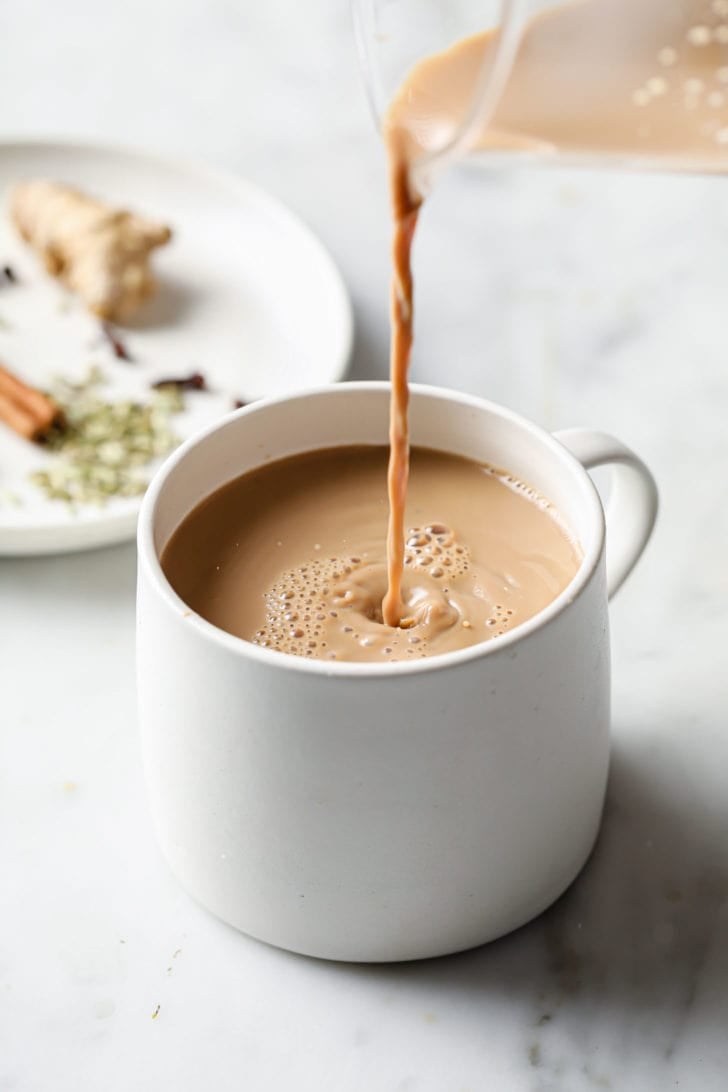
Want to save this post?
Enter your email below and get it sent straight to your inbox. Plus, get recipes & tips every week!
“This is truly the best thing I have drank in a long time. I plan to make it every day now! Thank you so much for the recipe and all the information!”
Jen
Why this recipe?
For many of us, not much thought goes into making Masala Chai. But if you haven’t made it before, there are a few things you want from a recipe. Here’s why you’ll like this one:
- It accounts for evaporation. This means you won’t set out to make 2 cups and end up with half a cup.
- The ginger is not overwhelming. Indian restaurants often add loads of ginger and let their chai sit for hours, which ends up making it a little uncomfortable to drink.
- Adding on to that, the spices in this recipe are balanced and not too pungent. Of course, you can customize each spice to your taste. But the base spice mix serves a neutral starting point so that no spice is overpowering.
- As always, it’s precise, easy-to-follow, and tested to perfection!
What is Masala Chai?
Masala chai (or Spiced Chai) is a traditional Indian tea made with spices, ginger, and milk. Though Masala Chai isn’t as popular in Pakistani culture as it is in Indian culture, growing up as a South Asian in America, I’ve had countless cups. Masala chai elevates a regular cup of chai with spices, making it even more relaxing, calming, and soothing to the senses. This article from Diaspora Co. showcases the history and evolution of Masala Chai.
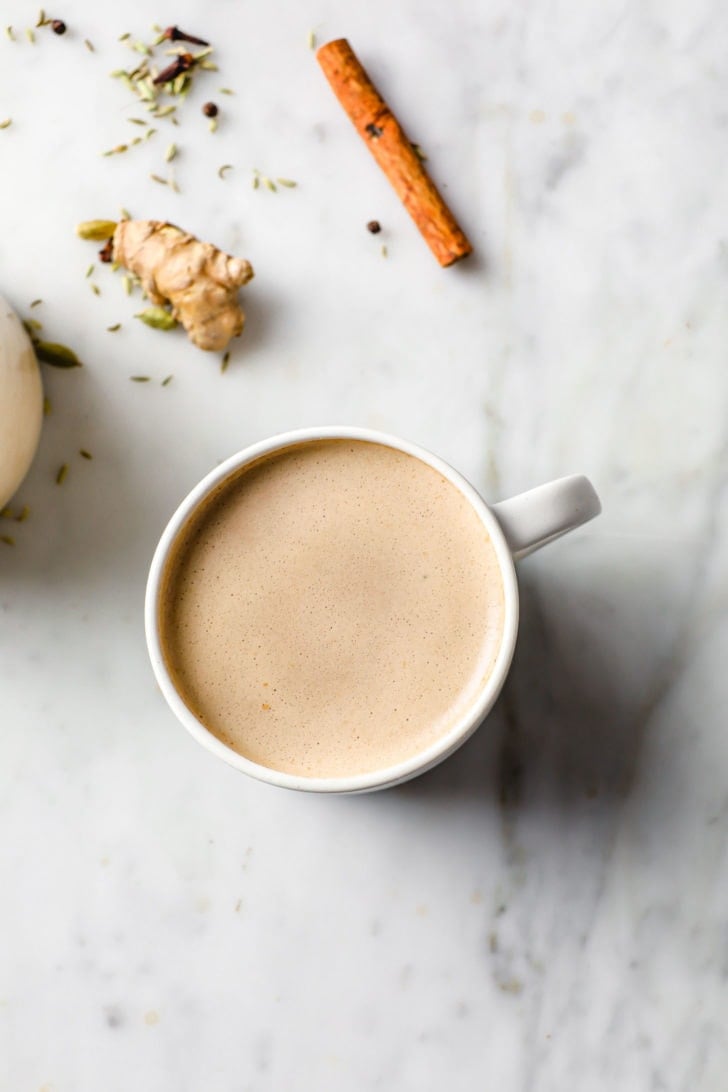
Chai vs Masala Chai
The word chai simply means tea. You have the simple, milky cup of chai, the characteristically pink Kashmiri chai, and many other popular versions of chai. Masala Chai is distinguished by the use of spices, or masala, in chai.
Masala Chai Vs Chai Tea
Yes, Chai Tea is a redundant term. (My friend Kathryn’s PSA on phrases like “Chai Tea” and “Chai-Spiced” explains it best.) But I do think that Chai Tea, initially a rendition on masala chai, has evolved into its own drink. When I think of Chai Tea or Chai Tea Lattes, I think of the coffee shop drink made with concentrated Chai flavor. It’s so different from traditional Indian Masala Chai, that it can safely be categorized as a completely different drink.
Masala Chai is made by simmering the tea with spices and cooking down the milk. This lends it a richer, creamier, more complex taste.
On the other hand, Chai Tea is made with steamed milk and has a more watered down yet sharp flavor (which comes from concentrate or powder). Masala Chai is typically not manually frothed while a Chai Tea Latte is distinctly frothy.
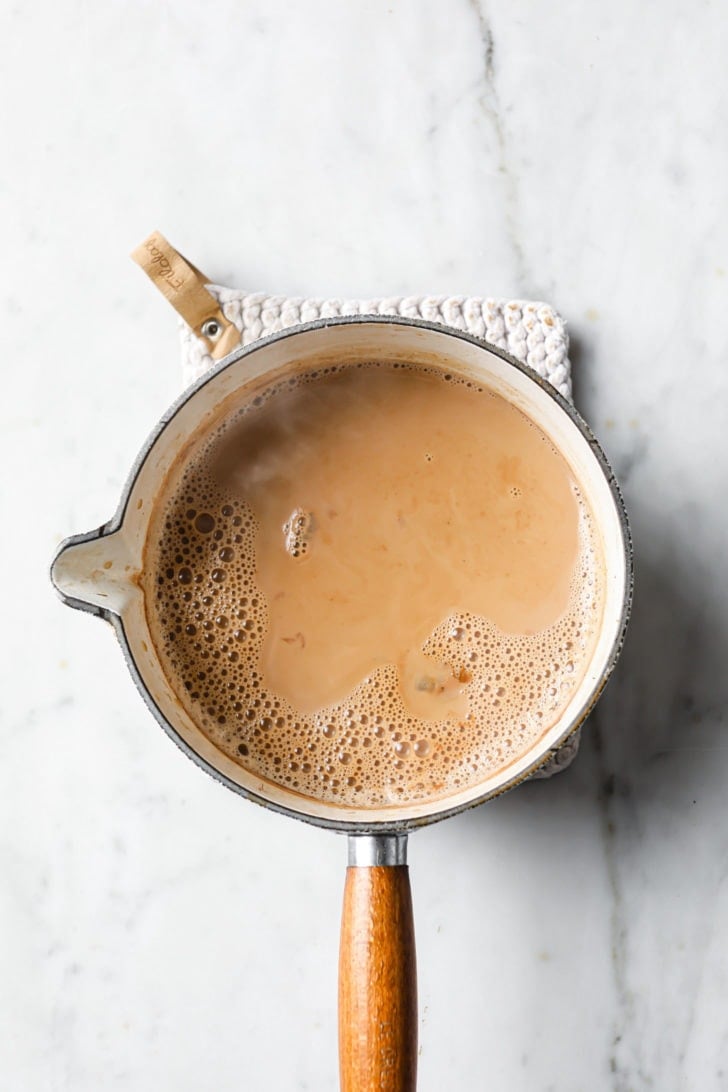
Masala Chai Ingredients
Tea bags, a few spices, milk, and sweetener are all you need to make this soul-soothing cup of chai. As always, if you’re missing a spice or two, don’t let that deter you from making it!
What type of Black Tea to use for Chai
I suggest using strong Pakistani/Indian black tea bags which are often made with Assam or Darjeeling tea leaves using the CTC method. Tapal, Wagh Bakri, Ahmad Tea, and Tetley are some of the brands commonly found in South Asian grocery stores. If using weaker tea or whole leaf Darjeeling or Assam, add more as needed (usually ~2 tbsp).
I developed this recipe with tea bags. If you prefer to use tea leaves, you certainly can. But depending on the brand, it may increase the strength of the tea and therefore make the spices more muted. Adjust by reducing tea and/or grinding the spices.
Other Ingredients
- Whole spices: This recipe uses 4 whole spices that are commonly used to make Masala Chai:
- Cinnamon sticks (both Cassia & Ceylon work here)
- Cloves
- Green cardamom pods
- Black peppercorns
- Fennel seeds – Optional, but I love how they make masala chai more vibrant. Some restaurants also use mint leaves which gives a similar, fresh flavor.
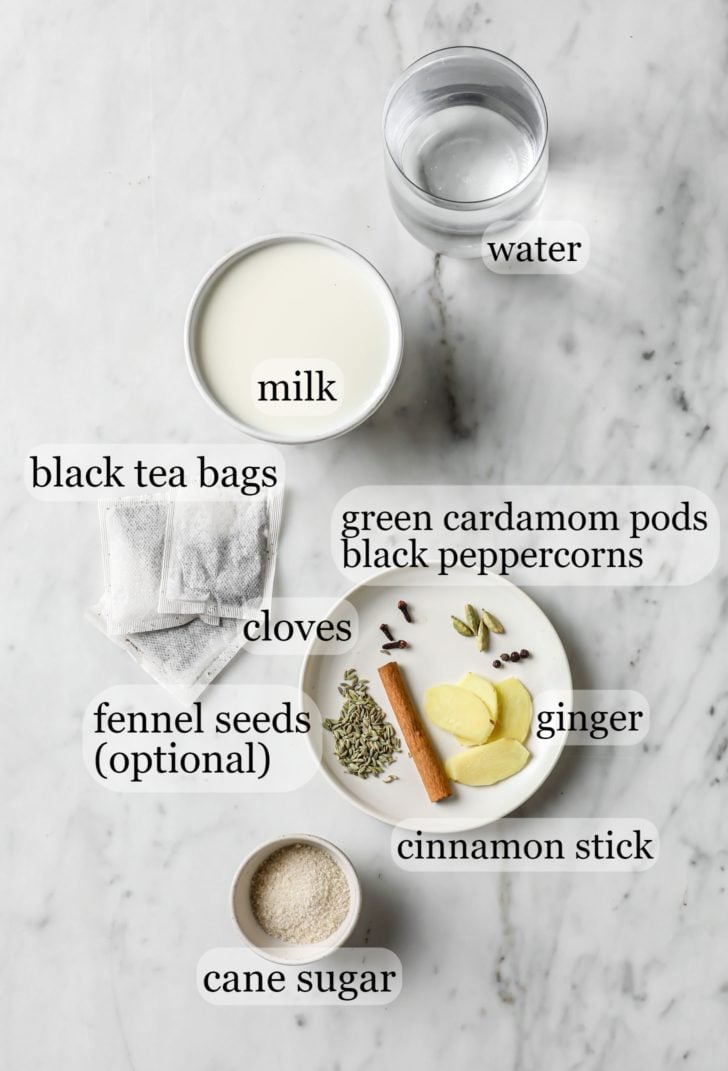
- Fresh ginger root: If I’m feeling under the weather, I’ll add another slice or 2 of ginger. Otherwise, I prefer the ginger to be subtle. For stronger ginger flavor, use a mortar & pestle to crush it instead of slicing.
- Milk: Feel free to use whole milk, reduced-fat milk, lactose-free milk, etc. For a dairy-free substitute, I’ve tried soymilk, which takes well to boiling. Here’s Minimalist’s Baker’s vegan version of Masala Chai in which she suggests using rich and creamy dairy-free milk such as oat milk or coconut milk.
- Sugar: Though a regular cup of chai is fine unsweetened, I find sweetener is critical to drawing out and balancing the spices of Masala Chai. I love using the less-processed turbinado (similar to demerara sugar) and adding it while making the chai. This way, it dissolves into the chai instead of settling down to the bottom of your cup. You can substitute with any sweetener of choice. If using honey or maple syrup, add it once you’ve taken it off the heat.
Whole Spices vs Ground Spices
I usually use the whole spices as-is for ease and because I find the long brew time is enough to extract their flavor. But I have tried grinding them and it does slightly increase their pungency.
- For a slightly stronger flavor of the whole spices, roughly crush the spices using a mortar & pestle.
- For even sharper, more pronounced flavor, grind them in a spice grinder to make a chai masala powder. It won’t change the flavor profile or throw off the balance of the spices, it’ll just increase their intensity. The drawback of this method is that remnants of chai masala powder may rest at the bottom of your cup.
How to make Masala Chai
Here’s how to make the perfect cup:
- Place a saucepan over high heat and add water. If you’re using a larger pan, add an extra 1/4 cup water to account for the extra evaporation. Add the whole spices & ginger while the water is coming to a boil.
- Throw in the tea bags (or leaves) and reduce the heat to a simmer so the tea and spices have time to infuse the water. Stop and smell the aroma of the spices here.
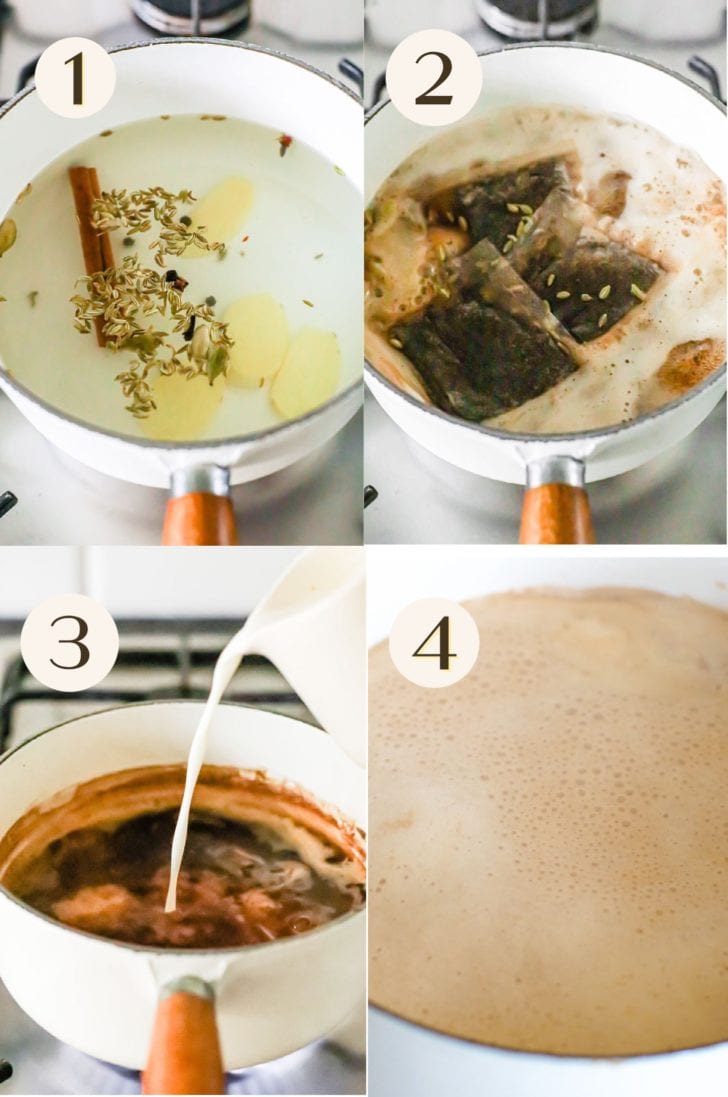
- Add the milk and sugar. Once it comes to a boil, lower the heat and allow it to simmer for another 5 minutes or so.
- Raise the heat to high and allow it to come to a rolling boil for a minute or so, depending on how ‘cooked’ you like the milk. There is no right or wrong, it simply boils down to 😉 preference.
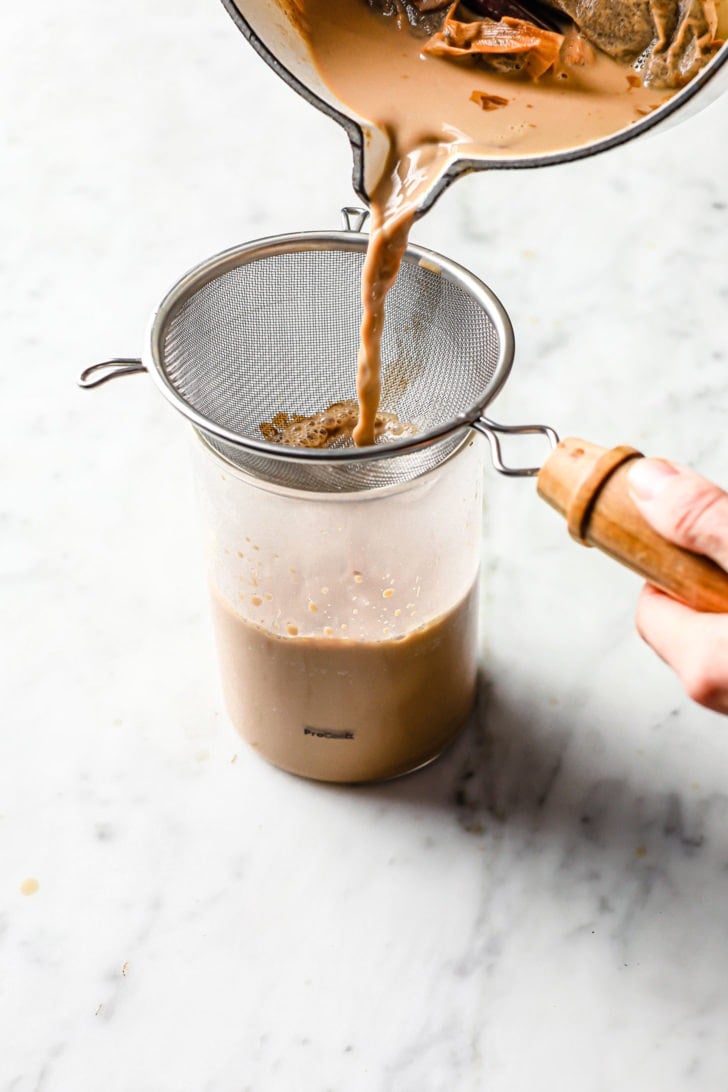
- Pour into cups through a strainer and discard tea bags & spices.
How to Aerate Chai
In Pakistan and India, Chai vendors (called chai walah) use a ladle to repeatedly scoop up and pour back the chai. I find this enhances the taste and creaminess.
Often, they’ll expertly pour the chai from a distance into small cups, creating natural, frothy bubbles. (Here’s a video by Travel Thirsty showing a chai vendor in India making masala chai. Toward the end, he aerates the chai by ‘pulling’ it from one cup to the next.)
Upon trying it, I noticed the more narrow the glass, the more frothy it gets (similar to how you need a narrow Turkish Ibrik to create froth on Turkish Coffee). Since most of us don’t have the hand-eye coordination of tea vendors, we can use a milk frother to create a similar effect.
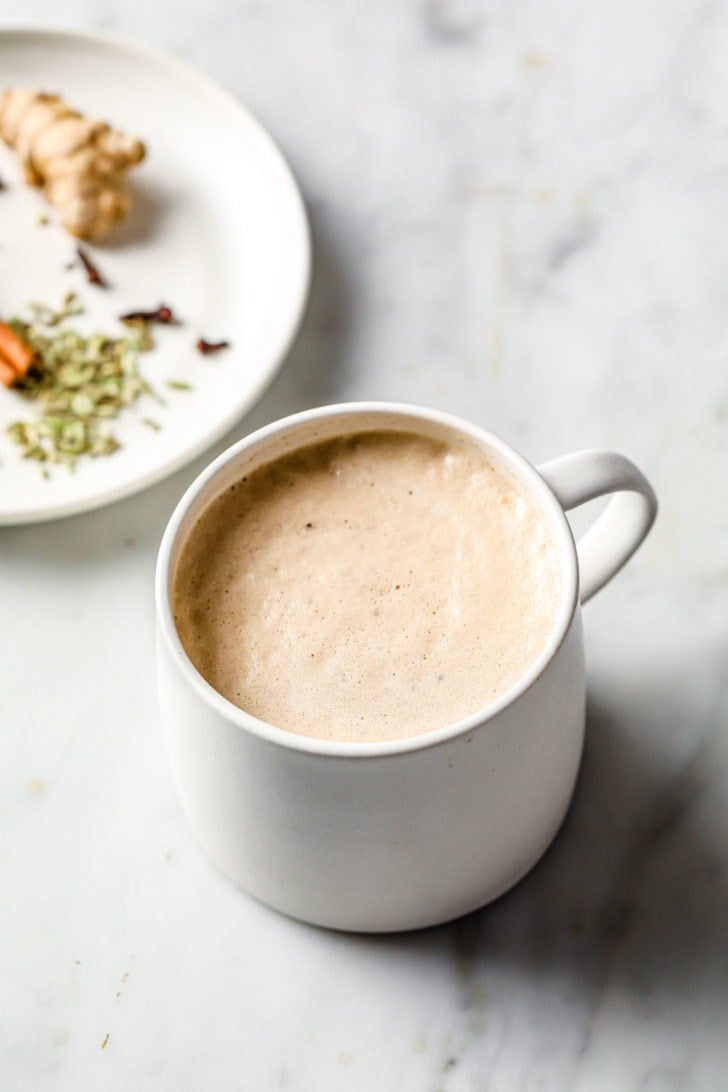
Tips for the perfect cup
- The type of tea you use is extremely important to the overall flavor. I usually use Tapal tea, but this may be more because we’re used to it than for its quality.
- If the color is not deep enough or the chai is not strong enough after you’ve allowed the milk to simmer for a few minutes, feel free to add more tea bags/tea leaves.
- Lastly, like with any drink, you’ll discover your ideal cup over time. Even while (gladly) testing this recipe many times, my preferences evolved and fluctuated.
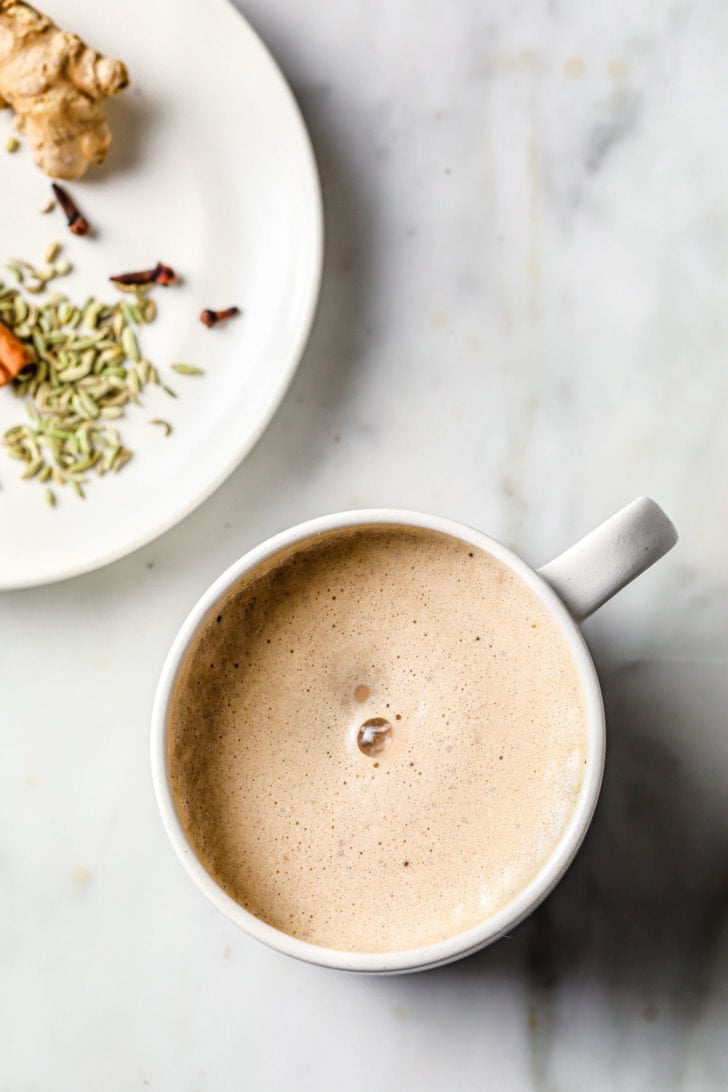
Variations
- For a lighter cup, sometimes I like to use a smaller quantity (~1/4 cup) of evaporated milk along with some whole milk. In this case, simmer for less time to keep it light.
- More ‘sweet’ spices you can try experimenting with: star anise, nutmeg, and saffron.
How to Serve Masala Chai
I love serving any type of milky tea with baked goods, cookies (or biscuits as many South Asians call them), or cake rusk. Since I sweeten Masala chai, it’s perfect as-is.
To Serve Iced: Allow to cool, then store in the fridge until chilled. Top with ice cubes.
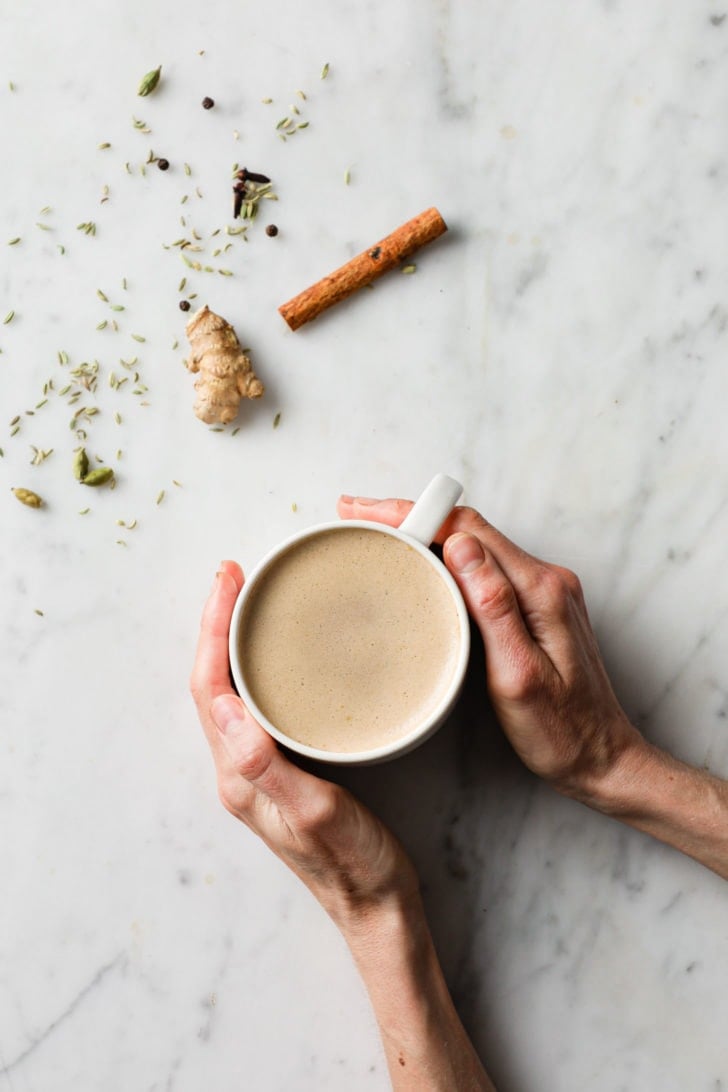
More Pakistani & Indian Drinks You’ll Love
20-Minute Kashmiri Chai (Pink Tea)
Pakistani Chai (also called Doodh Pati)
Plain Sweet Lassi
Turmeric/Golden Milk | Haldi Doodh
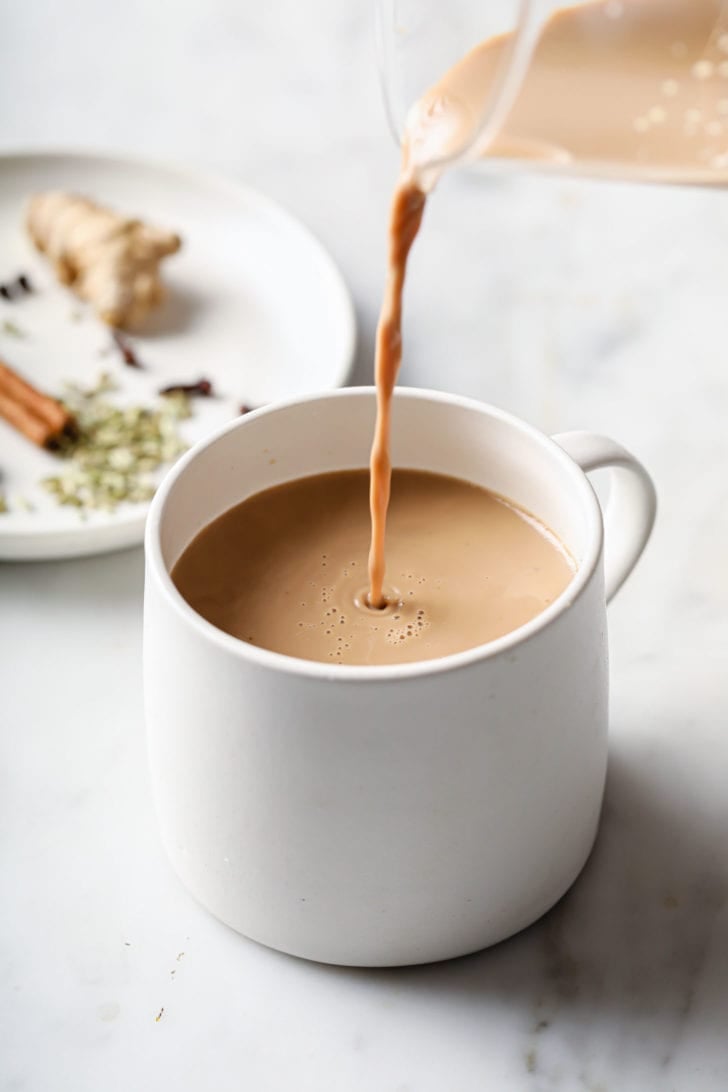
Tried this recipe? If you have a minute, please consider leaving a comment telling me how it was! If you’re on Instagram, please tag me so I can see your creations. I truly love hearing from you. Thank you!
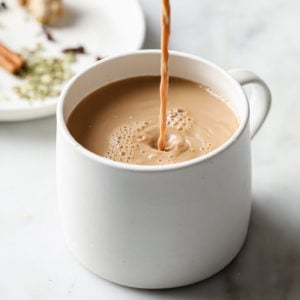
Easy Masala Chai (Tea) Recipe – Spiced Chai
Watch the Video
Ingredients
- 2 1/4 cups (532 ml) filtered water
- 1 3-inch cinnamon stick, ceylon or cassia are both fine
- 3 whole cloves
- 4 green cardamom pods, cracked open and deseeded (I throw seeds & pods in)
- 3 black peppercorns
- 1/2 tsp fennel seeds, optional
- 1/2- inch (~4 g) fresh ginger, peeled and thinly sliced
- 3 black tea bags or sub 3 tsp loose leaf black tea, depending on brand, tea bags/leaves vary in strength (See Note 1)
- 1 cup (8 oz) whole milk, or 2% reduced fat milk
- 4 tsp (20 g) turbinado cane sugar, or raw cane sugar
Equipment
- Medium (1-2 Quart) Saucepan – preferably nonstick
Instructions
- Heat a medium saucepan over high heat. Add water, cinnamon stick, cloves, cardamom pods, black peppercorns, fennel seeds (if using), and ginger. (See Note 2) Bring to a boil and add the tea bags or leaves.
- Reduce the heat to medium-low and simmer gently for 7-10 minutes, depending on how strong you’d like the tea and spices. It will turn a deep burgundy color and reduce slightly.
- Add milk and sugar and stir. Raise the heat to high (or allow the milk to come to a boil on its own, as I do on any given day). Reduce the heat to medium and simmer for another 5 minutes.
- When ready to serve, raise the heat to high and allow it to come to a rolling boil for 1-2 minutes, depending on how 'cooked' you like the milk. (See Note 3) If you’d like, use a ladle to aerate the chai to deepen the flavor and make it creamier.
- Pour into cups through a strainer and add more sweetener, if desired.
Notes
- I suggest using strong black tea bags which are often made with Assam or Darjeeling tea leaves using the CTC method. Some brands commonly available in South Asian grocery stores are Tapal, Wagh Bakri, Ahmad Tea, and Tetley. If using weaker tea like Twinings or Lipton, add an extra 1-2 tea bags. If using whole, loose leaf Assam or Darjeeling tea, you’ll need around 2 tbsp.
- I developed this recipe using tea bags. If you prefer to use tea leaves, you certainly can. But depending on the brand, it may increase the strength of the tea and therefore make the spices more muted. Adjust by reducing tea and/or grinding the spices.


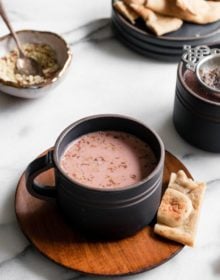
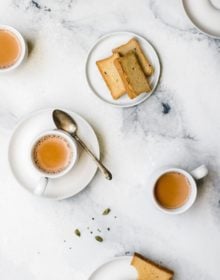
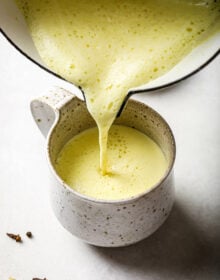
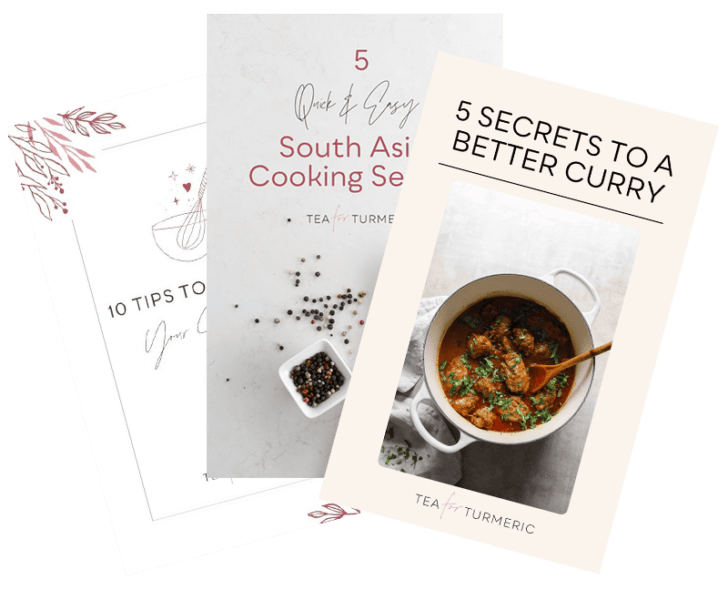
116 Comments on “Masala Chai (Tea) Recipe – Spiced Chai”
Easy and delicious. So much better than the “chai” you get at Starbucks or boba shops. Perfect for a rainy day or really any day. Thank you for the recipe 🙂
So delighted to hear that, Mari! Thank you!
I tried this tea hot and iced and it was delicious. This will be one of my must have tea.
Oh so yum! Thanks for sharing, Patricia!
So far this is my favourite Masala Chai recipe I have ever tried! I like the finished Chai gave a strong flavour highlights with a smooth texture. This is so similar to the amazing Chai I had in Indian restaurants!
I’m thinking of making a mocha ver using this recipe as the base, which I tried in a very good Indian restaurant before! I presume your recipe would make this idea great!
So nice to hear that. Thank you, Mag! I’m curious how mocha chai would taste. I’ll have to try sometime. Thanks for sharing!
I would love to try this and serve my in laws. How do you know how many tea bags to use? Is it two tea bags per person?
Hi Fozia, you’ll need at least one tea bag per person, possibly more if weaker tea. You can always 2x or 3x the quantities and it’ll adjust for you! Hope that helps 🙂
Hi Izzah! I tried this recipe twice and the spices are still coming out a bit weak. I even tried doubling them without much improvement. Any suggestions? I bought fresh ones so I doubt they’re too old. Thanks!
Hi Alex! To increase strength, try grinding them with a spice grinder or mortar & pestle. Hope you enjoy 🙂
It’s awesome!!! I’m hooked. I used too much pepper I think because it’s pretty spicy but I kinda like it that way. I also used Pyure granulated stevia and it’s just right. Thank you for this!
So wonderful! Thanks for sharing, Barbara!
This is truly the best thing I have drank in a long time. I plan to make it every day now! Thank you so much for the recipe and all the information!
I’m truly delighted to hear that, Jen. Thank you so much for sharing!
Can I make just the concentrate and store it in the fridge?
Hi Nini, I haven’t tried it but that’s a great idea. I think you could do that and then afterward add the milk and re-boil it. But I wouldn’t store it for more than a day or two because it’ll lose freshness. Hope that helps!
Just made, unfortunately I thought I already had cloves at home so missed out on that, and used coconut milk , looking forward to trying again with regular milk.
Hope you enjoyed it regardless, Jessica. Thanks for sharing!
this is beautiful.
its been a cold & rainy day, and i felt like having something “more than chai” and this was absolutely perfect. hit the spot!
followed the recipe to the letter. Love it!
Can’t wait to impress my MIL when she comes over next 😉
I’m so happy you found comfort in it. I agree – this totally adds something special to a good cup of chai. Thank you, Ramsha!